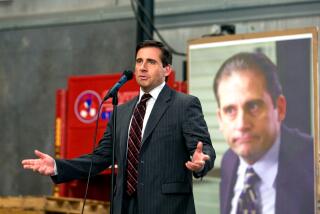Commentary : HOW ONE LITTLE MTM KITTEN STARTED SOMETHING BIG
- Share via
Painters sign their works, sometimes with a flourish. So do TV producers, who are--after all--electronic artists with big, big followings.
When those end credits roll, as viewers prepare to bolt for the kitchen, the savvy producer offers a signature with flair. A logo that marks the creator’s identity with eye-catching personality.
And, occasionally (this is television), more wit than the series preceding it.
Since MTM Enterprises’ mewing kitten popped on the scene in the early 1970s, tweaking the pretentious trademark ritual embodied by MGM’s roaring lion, the number of clever TV logos has multiplied.
Pre-MTM, we had a grimy arm pounding “Mark VII” into stone, a subtle way of announcing that viewers had just been bludgeoned by a program from Jack Webb’s (“Dragnet”) production company.
Or an authoritarian voice intoning “A Quinn Martin Production” (“The Fugitive,” “The F.B.I.”).
The message: These were serious professionals.
Then that darn cat changed everything.
Producers, who literally run the show in television, still sought to remind us that actors don’t make the story up as they go along. But the new breed of TV artist proved they could preen with style.
We got the likes of “Sit, Ubu, sit” for a Gary David Goldberg UBU Productions offering (“Family Ties”). It was a droll moment of fame for Goldberg’s dog, as well as Goldberg.
Or this winning program credit from the producers of “Taxi”: A weary figure shambles down a hallway as a voice calls out, “Goodnight, Mr. Walters.” A groan comes in reply.
A child’s voice proudly exclaims “I made this!” for Chris Carter’s Ten Thirteen Productions (“The X-Files”).
The logo is “meant as a lark,” says Carter. “I think all of us ultimately are the same kids making mud patties and showing our moms and dads. That’s what that’s about.”
Bruce Helford cooked up a unique I.D. for his upcoming Mohawk Productions series “Bless This House” and “The Drew Carey Show.” A sonogram shows Helford’s son Aven in utero; there’s a voice-over laugh from the boy, now 2.
“Mostly because it was a cute thing to do,” explains Helford. “Also probably, subliminally, because when you create [a show], you’re birthing something. A little bit of that, too.”
He consciously took a light approach: “I think everyone’s worried about coming off as too serious.”
Not quite everyone.
Stephen J. Cannell, seeking to retain his writer’s identity as he branched into producing on “The Rockford Files” and other series, inserted himself typing into his company’s logo sequence.
Steven Bochco (“NYPD Blue,” “L.A. Law”) pays tribute to his father’s musical artistry with the violinist’s image backed by the trill of Vivaldi’s “Four Seasons.”
We get the moon, a wolf and sometimes a plaintive howl to mark a Dick Wolf (“Law & Order,” “New York Undercover”) series.
Wolf concedes the logo credit matters to him.
“There is an economic basis to it,” he says. “Reputation in television is very important. You’re building goodwill by having that logo appear at the end of multiple shows.”
Not everyone who wants a logo gets one.
A network trend toward erasing between-show “clutter” has put logos on the endangered list. Carter had to fight to keep the distinctive opening credits for his “X-Files,” let alone the brief “I made this!” end chortle.
Wolf says his company logo has been diminished.
“A couple networks cut out the sound. Run in its full glory you hear the howl,” he said. “It’s still on Fox. On NBC, I don’t think we get the howl. We had a partial howl on CBS; they couldn’t decide which way to go.”
During “spirited discussions” to protect his signature, Wolf argued that it helps build reputation and attract viewers.
“The networks say that isn’t true. I say, ‘So why don’t you take your logo off?’ ”
More to Read
The complete guide to home viewing
Get Screen Gab for everything about the TV shows and streaming movies everyone’s talking about.
You may occasionally receive promotional content from the Los Angeles Times.






